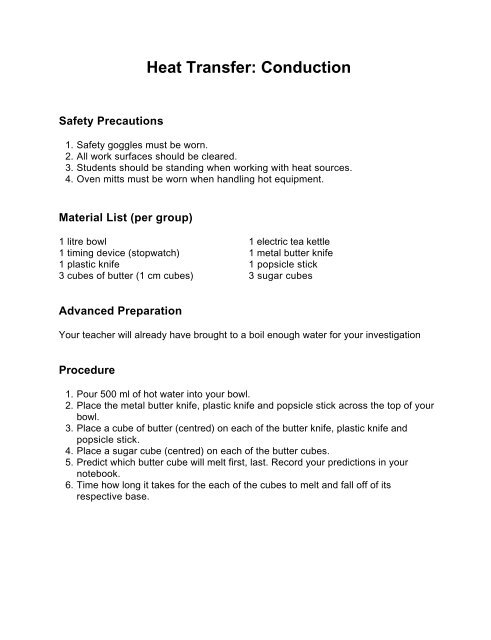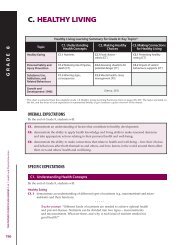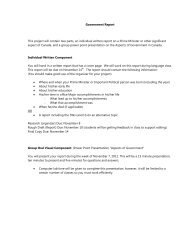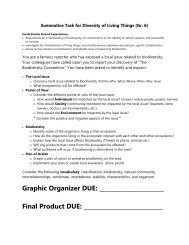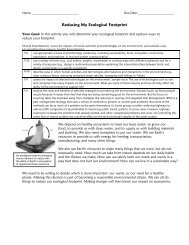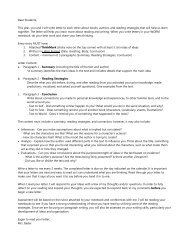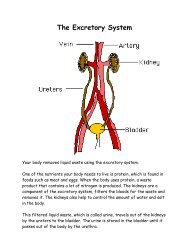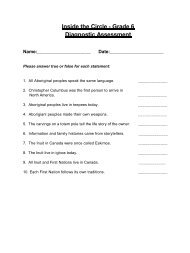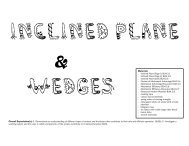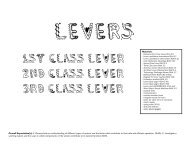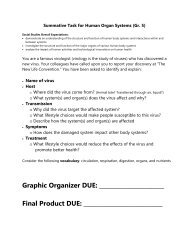Heat Transfer: Conduction
Heat Transfer: Conduction
Heat Transfer: Conduction
Create successful ePaper yourself
Turn your PDF publications into a flip-book with our unique Google optimized e-Paper software.
Safety Precautions<br />
<strong>Heat</strong> <strong>Transfer</strong>: <strong>Conduction</strong><br />
1. Safety goggles must be worn.<br />
2. All work surfaces should be cleared.<br />
3. Students should be standing when working with heat sources.<br />
4. Oven mitts must be worn when handling hot equipment.<br />
Material List (per group)<br />
1 litre bowl 1 electric tea kettle<br />
1 timing device (stopwatch) 1 metal butter knife<br />
1 plastic knife 1 popsicle stick<br />
3 cubes of butter (1 cm cubes) 3 sugar cubes<br />
Advanced Preparation<br />
Your teacher will already have brought to a boil enough water for your investigation<br />
Procedure<br />
1. Pour 500 ml of hot water into your bowl.<br />
2. Place the metal butter knife, plastic knife and popsicle stick across the top of your<br />
bowl.<br />
3. Place a cube of butter (centred) on each of the butter knife, plastic knife and<br />
popsicle stick.<br />
4. Place a sugar cube (centred) on each of the butter cubes.<br />
5. Predict which butter cube will melt first, last. Record your predictions in your<br />
notebook.<br />
6. Time how long it takes for the each of the cubes to melt and fall off of its<br />
respective base.
Analysis Questions<br />
1. Construct a bar graph whose horizontal axis (x-axis) records the type of conductor<br />
and whose vertical axis (y-axis) records the duration of heat conduction. Plot and<br />
compare.<br />
2. Explain the process of conduction as you observed it. In your observations, which<br />
material served as the best conductor? Worst conductor?.<br />
Relating Science and Technology to the World Outside<br />
According to your knowledge of conduction, would it be more advisable to install airconditioning<br />
vents on the ceiling or on the floor? Would the same advice apply to<br />
furnace heating? Baseboard electrical heating?<br />
Culminating Task Considerations<br />
Select a material which will generate optimum heat transfer through conduction.<br />
Consideration must be given to the placement of heating and cooling elements.<br />
Record all observations, skills, facts, and questions during the investigation. There is<br />
a direct connection between this subtask and the culminating task. Having a<br />
thorough notebook will assist you in the end. You may wish to consult with your group<br />
and/or teacher regarding verification or clarification.
<strong>Conduction</strong> Craze Name:________________<br />
Thought Experiments Date: ________________<br />
Activity 4<br />
Discuss the following situations with your group members and try to solve the<br />
problems by applying what you know about the transfer of heat by conduction. A<br />
reminder that materials that transfer heat well by conduction are called conductors,<br />
while materials that do not conduct heat efficiently through their atoms are called<br />
insulators.<br />
A. It is 9:00 p.m. on a warm July night. The sun set at 8:36 p.m. Two houses sit side by side; one<br />
with white vinyl exterior siding, the other with red clay brick finishing. You touch each house to find<br />
that the red clay brick house feels much warmer to your hand than the white vinyl sided house. Why<br />
is this so?<br />
______________________________________________________________________________<br />
______________________________________________________________________________<br />
______________________________________________________________________________<br />
B. It is a mid October morning. A light dusting of snow had fallen overnight. You had helped clean<br />
out the garden the previous night and left some tools outside. While picking up a metal hand shovel,<br />
you observe that it feels much colder than the plastic hand grips of the pruning shears. Is the metal<br />
hand shovel really colder than the pruning shears? How can you explain this?<br />
______________________________________________________________________________<br />
______________________________________________________________________________<br />
______________________________________________________________________________<br />
C. A large layer of ice about 3 cm in thickness has built up in your freezer. Do you think this is good<br />
for the energy efficiency of your freezer? Explain why or why not.<br />
______________________________________________________________________________<br />
______________________________________________________________________________<br />
______________________________________________________________________________<br />
D. Your neighbour has complained that the concrete floor in his basement is almost always cold. He<br />
just installed new carpeting and under-padding, but the floor still seems cold. Why is this so? What<br />
could the neighbour have done to avoid this problem?<br />
______________________________________________________________________________<br />
______________________________________________________________________________<br />
______________________________________________________________________________<br />
BLM 3.5
<strong>Conduction</strong> Craze Name:________________<br />
Marshmallow Madness Date: ________________<br />
Activity 1<br />
As you know, roasting marshmallows is a favourite summer outdoor activity that many<br />
people enjoy. A company that produces cookware utensils has asked you and your<br />
group to determine what material should be used in making marshmallow roasters.<br />
Assume the utensil would not be held directly in the fire, but close enough to roast the<br />
tantalizingly tasty treat. Your group must test four different materials before making a<br />
decision.<br />
PROBLEM:<br />
What material would serve as the best material for making marshmallow roasting<br />
utensils?<br />
MATERIALS:<br />
20 cm pieces of wood (could use pencils or skewers), plastic or plastic straws, glass,<br />
metal (could use butter knife), water, kettle, marshmallows, and 250 mL beaker.<br />
PROCEDURE:<br />
1. Place a marshmallow at the end of a 20 cm piece of each substance.<br />
2. Place the other end in a 250 mL beaker of boiling hot water.<br />
3. Carefully observe what happens to the marshmallow at the end of each material.<br />
4. Clean up all materials before rotating to the next centre.<br />
OBSERVATIONS:<br />
__________________________________________________________________<br />
__________________________________________________________________<br />
__________________________________________________________________<br />
CONCLUSION: What type of material would you suggest the company use for their<br />
marshmallow roasting utensils? Is there a possible combination of materials that<br />
could be used? What material conducted the heat from the water most quickly?<br />
__________________________________________________________________<br />
__________________________________________________________________<br />
__________________________________________________________________<br />
__________________________________________________________________<br />
BLM 3.2


